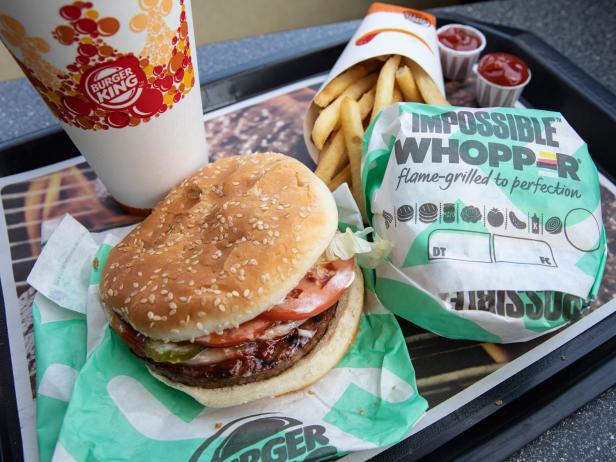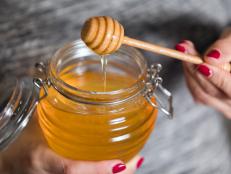Is Plant-Based Meat Actually Better for You?
A registered dietitian breaks down the good, the bad and the confusing information surrouding trendy plant-based "meat."

Drew Angerer/Getty Images
The plant-based trend continues to grow, encouraging people to eat more fruits, vegetables, legumes, nuts and seeds. In response to consumer demands for plant-based options, companies have been developing plant-based alternatives to staples like meat, eggs and dairy. One of the more popular plant-based groceries on the market is plant-based meat with Impossible Foods and Beyond Meat being the top sellers in this category.
According to Reuter’s, Beyond Meat, Inc shares are up over 700% since the company went public in May 2019 and it's forecast that revenue will rise more than 170% in 2019. Impossible Foods isn’t doing too shabby either; they struck a deal with Burger King to launch the Impossible Whopper nationally. Many folks who turned to plant-based meat credit the environmental benefits. This reasoning is sound, but what about the taste and nutrition of these plant-based meats? We investigate.
What Is Plant-Based Meat Made Of?
Plant-based meat brands claim they are creating products that have the same flavor, juiciness and sizzle as beef. They’re even made to "bleed" like meat. Here’s a look into the most popular two companies, Beyond Meat and Impossible Foods, and what their meatless burgers are made from.
While the Beyond Burger is made without GMOs, soy or gluten, it still has a lengthy ingredient list.
"Water, Pea Protein Isolate, Expeller-Pressed Canola Oil, Refined Coconut Oil, Rice Protein, Natural Flavors, Cocoa Butter, Mung Bean Protein, Methylcellulose, Potato Starch, Apple Extract, Salt, Potassium Chloride, Vinegar, Lemon Juice Concentrate, Sunflower Lecithin, Pomegranate Fruit Powder, Beet Juice Extract (for color)"
The protein in this burger comes from rice, peas and mung bean, and the fat comes from canola oil, coconut oil and cocoa butter. Instead of using an egg to bind, an additive called methylcellulose is used. This binding agent is also commonly used in ice cream, jams and sauces.
A 4 ounce serving of the Beyond Burger provides Calories: 250; Total Fat: 18g; Saturated Fat: 6g; Protein: 20g; Total Carbs: 3g; Fiber: 2g; Sodium: 390mg
Impossible Foods created plant-based heme (an iron-containing molecule that occurs naturally in every living plant and animal) through the fermentation of genetically engineered yeast, which is explained on the Impossible Foods website. In 2019, Impossible Foods updated their original recipe formula and the latest Impossible Burger debuted. The long list of ingredients is as follows:
"Water, Soy Protein Concentrate, Coconut Oil, Sunflower Oil, Natural Flavors, 2% or less of: Potato Protein, Methylcellulose, Yeast Extract, Cultured Dextrose, Food Starch Modified, Soy Leghemoglobin, Salt, Soy Protein Isolate, Mixed Tocopherols (Vitamin E), Zinc Gluconate, Thiamine Hydrochloride (Vitamin B1), Sodium Ascorbate (Vitamin C), Niacin, Pyridoxine Hydrochloride (Vitamin B6), Riboflavin (Vitamin B2), Vitamin B12."
As you can see, many vitamins and minerals are fortified into the mixture in order to have the nutritionals match that of beef. The protein sources include soy and potato, fat comes from coconut oil and sunflower oil, while the binding agent used is methylcellulose (just like Beyond Burger).
The nutrition info per 4 ounce serving is Calories: 240; Total Fat: 14g; Saturated Fat: 8g; Protein: 19g; Total Carbs: 9g; Fiber: 3g; Sodium: 370mg.
The Impossible Burger has a similar nutritional profile to Beyond Burger. It’s an excellent source of most of the B-vitamins and zinc, and good source of calcium, potassium, and phosphorus.
But Do They Taste Like Beef?
I had the pleasure of dining at Joe & Joe Nyack, Italian Eatery where I realized that Beyond Meat was used in a meatball dish. The chef was kind enough to give me a taste, and although it has the consistency of beef, the flavor was more like a veggie burger than beef. I was curious to consumer response of this offering and asked Anthony Longobardo, Owner and Operator at Joe & Joe Nyack who said, “From the first day we opened, the response to the Impossible Burger and mostly our Impossible Meatballs over spaghetti squash was overwhelmingly positive.” The restaurant has since switched to using Beyond Burger "meat" as a result of high demand from consumers. "We ... also received a positive response,” explained Longobardo.
Are They Healthy?
With many, many ingredients in both plant-based meats, there’s a lot of processing that goes into making them. And because the nutritional content is similar to beef, these plant-based meats are about equal in calories and saturated fat, and higher in carbs and sodium. Plant based meats do provide more fiber, but from fiber added into the ingredients — not from actual food like legumes, nuts, seeds or whole grains.
Although trying the plant-based meats sounds like a novel experience, I would prefer to make my own veggie burger with wholesome ingredients or have a 3- to 4-ounce portion of lean meat, poultry or fish with vegetables, legume, and whole grain sides.
Toby Amidor, MS, RD, CDN, is a registered dietitian and consultant who specializes in food safety and culinary nutrition. She is the author of The Greek Yogurt Kitchen: More Than 130 Delicious, Healthy Recipes for Every Meal of the Day.
*This article was written and/or reviewed by an independent registered dietitian nutritionist.
Related Links:


































